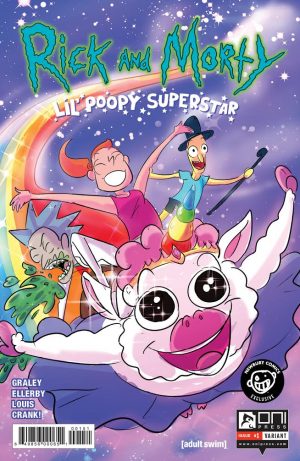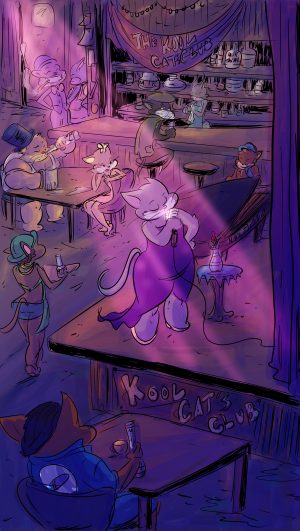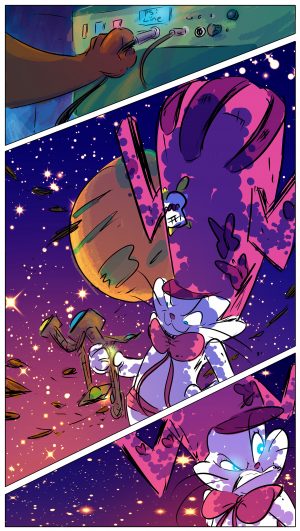The Art and the Art of Teaching Comics: Ahmad Rashad Doucet
We arranged to meet in the afternoon at a gamer pub in Savannah. Above me a projector blasted a game of Pokken Tournament on a screen that filled the wall over my shoulder. As I waited, I sipped on a cocktail named the “Master Chief.” At the high tops, a group of college students blew off some steam with the politically incorrect megahit, Cards Against Humanity. Then, Ahmad Rashad Doucet swung open the front door and filled the place with sunshine that had gamers squinting and turning away as though vampirism drove them to shun the light. He laughed in admiration at my Star Wars themed AT-AT t-shirt. We sat down and ordered nachos to munch on while we talked.
“I gotta ask you something about comics.”
“Okay, shoot,” he responds before biting down.
“Stephen King wrote that no one asks him about the language.”
Rashad chuckled and nodded, knowing where I was going with this.
“So tell me about the art.”
 I chose Rashad to answer that inquiry because of his faculty position at the world-renown school for arts, SCAD (Savannah College of Art and Design). Besides the teaching gig, his professional dossier includes work with Stela, Slave Labor Graphics, Mascot Books, Zuda Comics, and Oni Press. He did illustrations for Star Wars Celebration, as well.
I chose Rashad to answer that inquiry because of his faculty position at the world-renown school for arts, SCAD (Savannah College of Art and Design). Besides the teaching gig, his professional dossier includes work with Stela, Slave Labor Graphics, Mascot Books, Zuda Comics, and Oni Press. He did illustrations for Star Wars Celebration, as well.
Just a few months ago he and Matt Gardner teamed up for the graphic novel Alabaster Shadows. Think of the work as a Stranger Things with a little more Lovecraft and a broader audience. Garnering critical and fan praise, Alabaster Shadows reaffirmed Doucet’s talents to his audiences and to me.
If anyone could help me understand sequential art better from the illustrator’s perspective, he can.
CB: What got you interested in sequential art?
ARD: My grandma. She would tell me bedtime stories of Spider-Man and the Hulk. My favorite one was when I asked her how the Hulk became the Hulk. She told me he got stuck in a washing machine, and when he came out, he was the Hulk. That got me hooked. She would buy me comics if I did well in school.
I grew up in Eunice, Louisiana, and before I moved to New Orleans, there were no comic shops. There was one comic shop that was run out of some guy’s garage. It was the 90's, and "The Age of Apocalypse." I bought up every issue from him.
And when I was little, I made a lot of noise in church. To keep me quiet, Grandma gave me paper and told me to draw. I would write a lot of my stories. I was more of a writer when I started out…
 When I got into high school, I got into Superman. A lot. I was a hater of Superman until I read Kingdom Come and "The Death of Superman," and that made me like Superman and want to try and write and draw full pages. I started drawing full pages in high school.
When I got into high school, I got into Superman. A lot. I was a hater of Superman until I read Kingdom Come and "The Death of Superman," and that made me like Superman and want to try and write and draw full pages. I started drawing full pages in high school.
Now, I was playing basketball and other stuff that kind of took away from that. There was a teacher who told me about SCAD, but I thought it was too expensive. And I thought I couldn’t make it. I went to college at University of New Orleans and took Fine Art.
Then, Hurricane Katrina happened. I reprioritized. All along I knew I loved comics. I would fly all over for conventions or drive nonstop with friends from New Orleans to Wizard World Chicago. We went from the top of the country to the bottom. It was a crazy drive, but we were trying to break into comics…
I focused entirely on comics and relocated here [Savannah]. I started SCAD and got work in the third quarter of my masters… I have been freelancing and working with Oni ever since.
CB: What was the best lesson from your personal education at University of New Orleans and SCAD that you learned?
ARD: I would say not letting my fandom hold me back. As artists and creators and fans, we’re so dedicated to certain things. We get so wrapped up in “this is how you do it” that we limit the amount of people we could work for and the potential we have by being stunted by our fandom of one thing or company. Even though I am a fan of a lot of things, I am willing to work on anything. Especially in terms of stepping outside the boundary and analyzing things from different ways.
Look at Twilight. Why does it work? It’s badly written. I’m not the biggest fan of it, but it’s affecting people. You can’t let your hate of it wash it out because it’s working. I look at Rob Liefeld. A lot of people don’t like him. But he was on The Tonight Show talking about comics. He’s doing something right. His work is resonating with people. I would love to work with him because he knows what he’s doing and he knows a lot about surviving. He’s been doing it since he was fifteen or sixteen years old. I respect his work ethic. His hustle.
What holds back so many artists is that they want everything to be one way. They want to be like their favorite artist, but they aren’t willing to go a different path. Your favorite artist’s path is not your path.
CB: What was the best lesson you learned from your professional experience?
ARD: Learn how to work with others. Truly take direction and don’t get too caught up in yourself. Most of all: be able to work, not fast but fast and good. Learn how to meet your deadline. I have to juggle day-to-day stuff and work. Compartmentalize the day. If I’m playing video games, I’m giving myself an hour. That’s the key.
CB: What lesson do you work at the most to impart to students in your sequential art classes?
ARD: Be willing to expand past your comfort zone. So many students are so zoned focused that they want to work at this one company and this one place, and that’s not how this works at all. All your favorite artists are working on several projects. Until you have been in the industry for a while and you get the big contracts, that’s when you will be working for one person.
And think of the business like Speed from Speed Racer. No one liked that movie. But I liked how Speed learned of all the problems in racing: corporate interference, his missing brother. You, like Speed Racer, have to take all that stuff and just race. Once you see the other side of the fence, the more business side of it--that could break you. Don’t let it. People do this job because they love it. But it is a business. You have to accept that.
Ultimately, the beauty of comics is that you can forge your own path. You can forge your own path easily.
 CB: What do you think is the strength of students?
CB: What do you think is the strength of students?
ARD: Passion.
CB: What should a student do to prepare for schooling in sequential art?
ARD: Draw backgrounds. The main thing that students and young artists do is draw their favorite characters. They draw them standing up, sitting, and action poses. But they don’t draw what’s around them.
I always bring up the movie Big Hero 6. Hiro looks cool. Baymax looks cool. But look at Hiro’s room. Look at all the cool stuff that defines his character.
It’s good to develop all your skills at one time. You can get really good at drawing people, but draw the tree next to him. Some people will say that they don’t like drawing trees. They say it’s boring, but that’s what’s going to help you. It gets you better. Companies like Marvel and DC looking for artists need to know you have the capability to draw a background. People don’t think to draw a chair behind Spider-man, but you can put some really cool stuff on it.
When I look at people’s portfolios, I see they draw perfect rooms with all the standard items but none of the personality that our real life rooms reflect. I ask them, “Whose room is that? No one has a room like that.”
So draw a lot, but sketch all kinds of things. And most of all, don’t redraw a picture. Anyone who reads comics will recognize a Jim Lee picture. I feel you learn more by coming up with your own pose rather than drawing over a Jim Lee drawing.
CB: Do you have a go-to example of a perfect or near perfect graphic novel or comic book that you use as an example when you teach?
ARD: That depends on the genre. But I look for a good artist. Look at Stuart Immonen’s artwork. He tells great stories. Or look at Ohba’s Death Note. Look for artists that tell a story clearly and get you to care about the heroes, even the villains. My favorite comic for me personally is All-Star Superman #6. Superboy deals with the death of Jonathan Kent. You see the story where Superman has to accept that no matter how fast he is and no matter how powerful he is, he can’t stop a heath attack. I felt like that was just a really powerful moment to show a side of a character without making him seem weak. The best comics will be powerful and relate to you.
CB: If you could fix one thing about the industry right now, what would that be?
ARD: We need to become more extroverted. As evidenced by the film and television industry, people are willing to spend tons of money on comic book based properties. from The Flash to The Walking Dead, people are craving entertainment based on what we create, and I want to see more creators embrace this. Be willing to publicly promote their work, not just as cons but in their local shops and libraries, interacting more with people who aren't typical fans and embracing them.
People in the comic industry are so stuck in their singular vision that they don’t realize how big their empires could be. We need to look past that “I’m in a basement with my friends thing.” Let’s look like “I’m in a store on display with my friends” thing. Some people get it. Stan Lee gets it. He knows the importance of being a public face. It’s scary. None of us are used to being a public face in comics. That’s what we need. I don’t want all the scandals and crap that comes along with celebrities. But be willing to talk to a mom and a dad in a store.
And be like a sports fan. I’m not a Saint’s fan, but I will talk about that team or football in general to anyone. That’s what the comic book world needs. I want comics to be more like sports in that way.
 CB: What do you admire about the comic book industry today?
CB: What do you admire about the comic book industry today?
ARD: Diversity. And conversations about it. People mad about this and that. All that. We need all sorts of creators, we need all sorts of characters. There are so many types of comics that you can’t read all of them. That’s a great thing.
We live in a weird golden age. I go to ComiXology, and I’m glad that they have their unlimited subscription and Submit sections. There’s so much I can read. Valiant and Lion’s Forge have a bunch of cool stuff. There’s just so many more things to get into. When I grew up in the 90's, we had Marvel, DC, and later Image. Now there are twenty, thirty companies as well as other people just trying to tell their stories. I hope we can continue down that road.
The big companies are also reinventing their characters. People say that superhero stories are all done, but I don’t think that. New writers and artists like David Walker and Babs Tarr are bringing a whole new voice to characters.
And the support to new comics is great, as well. I watched Walking Dead #1 rise. I have a copy—somewhere. I hope I can find it. I wasn’t a big fan, but I liked that it was different. It’s in a sealed bag, and it’s safe.
But comics are diverse and expanding.
Having felt satisfied that I learned more about art I ended the official interview. We talked on about comics while many Pokemon battled just behind us. Rashad explained that he is working on some big projects, but as with all creative types, he needs to keep them secret for now. Check out Alabaster Shadows and Spacetails with him and Rahal, and head back here at Comic Bastards for more on his perspective of illustrating, writing, and teaching sequential art.